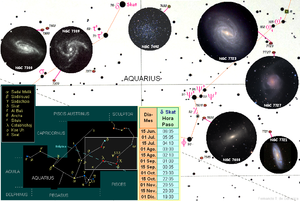NGC 7300
| Galaxy NGC 7300 |
|
|---|---|

|
|
| AladinLite | |
| Constellation | Aquarius |
|
Position equinox : J2000.0 , epoch : J2000.0 |
|
| Right ascension | 22 h 30 m 59.9 s |
| declination | -14 ° 00 ′ 13 ″ |
| Appearance | |
| Morphological type | SAB (rs) b: / HII |
| Brightness (visual) | 12.9 mag |
| Brightness (B-band) | 13.6 mag |
| Angular expansion | 2.1 '× 1.0' |
| Position angle | 160 ° |
| Surface brightness | 13.5 mag / arcmin² |
| Physical data | |
| Affiliation | LGG 458 |
| Redshift | 0.016265 ± 0.000033 |
| Radial velocity | 4876 ± 10 km / s |
|
Stroke distance v rad / H 0 |
(222 ± 16) · 10 6 ly (68.1 ± 4.8) Mpc |
| history | |
| discovery | John Herschel |
| Discovery date | July 26, 1830 |
| Catalog names | |
| NGC 7300 • IC 5204 (?) • PGC 69040 • 930291 • MCG -02-57-011 • IRAS F22283-1415 • 2MASX J22305991-1400127 • NVSS J223100-140011 • LDCE 1518 NED005 | |
NGC 7300 is a bar-spiral galaxy with extensive star formation regions of the Hubble type SBb in the constellation Aquarius on the ecliptic . It is an estimated 222 million light-years from the Milky Way and about 135,000 light-years across.
The galaxies NGC 7298 , NGC 7302 are located in the same area of the sky .
The supernovae SN 1996ca ( Type Ia ) and SN 2015au (Type IIb) were observed here.
The object was discovered on July 26, 1830 by the British astronomer John Herschel .
NGC 7300 group ( LGG 458 )
| Galaxy | Alternative name | Distance / million Lj |
|---|---|---|
| NGC 7300 | PGC 69040 | 222 |
| NGC 7251 | PGC 68604 | 221 |
| NGC 7298 | PGC 69033 | 229 |
| PGC 68593 | MCG -03-57-001 | 230 |
| PGC 68958 | MCG -03-57-008 | 196 |
